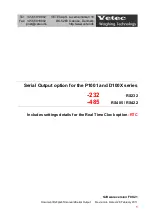
EL160.120.39 Operations Manual (020-0344-00A)
3
Installation and Handling
Do not drop, bend, or flex the display. Do not allow objects to strike the
surface of the display.
CAUTION: The display uses CMOS and power MOS-FET devices. These
components are electrostatic sensitive. Unpack, assemble, and examine this
assembly in a static-controlled area only. When shipping, use packing
materials designed for protection of electrostatic-sensitive components.
CAUTION: To prevent injury in the event of glass breakage, a protective
overlay should be used on the viewer side of the display.
Mounting
Properly mounted, EL displays can withstand high shock loads as well as
severe vibration found in demanding applications. However the glass panel
used in an EL display will break if subjected to bending stresses, high impact,
or excessive loads.
Avoid bending the display. Stresses are often introduced when a display is
mounted into a product. Ideally, the mounting tabs of the display should be
the only point of contact with the system. Use a spacer or boss for support;
failure to do so will bend the display and cause the glass to break. The
instrument enclosure or frame should not flex or distort in such a way that
during use the bending loads might be transferred to the display. Mounting
surfaces should be flat to within ±0.6 mm (±.025"). Use all the mounting holes
provided. Failure to do so will impair the shock and vibration resistance of the
final installation.
The EL160.120.39 is a tab mounted display. Use appropriate length standoffs
to assure that screws through the mounting tabs do not introduce bending
stresses into the display. Do not deflect the circuit board out of its normal
plane.
WARNING: These products generate voltages capable of causing personal
injury (high voltage up to 230 V
ac
). Do not touch the display electronics
during operation.
Cable Length
A maximum cable length of 600 mm (24 in.) is recommended. Longer cables
may cause data transfer problems between the data transmitted and the
display input connector. Excessive cable lengths can pick up and source
unwanted EMI. There are techniques which allow this maximum cable length
to be exceeded. Contact Planar Application Engineering for more information.

































